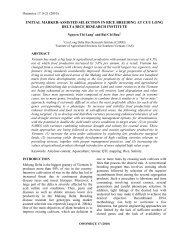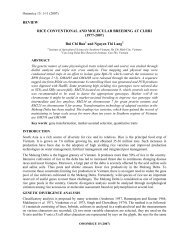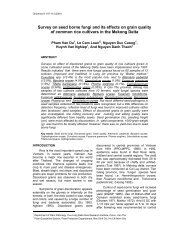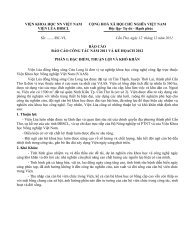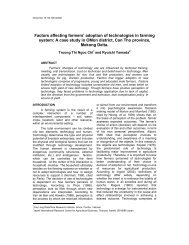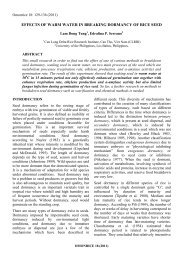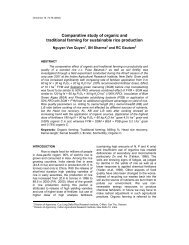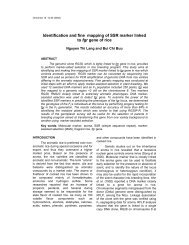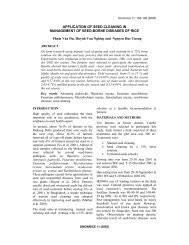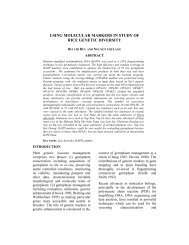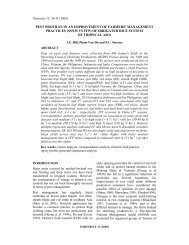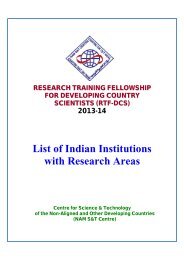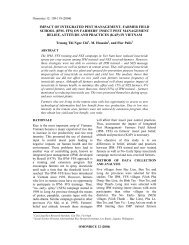[Glycine max (L.) Merrill] USING Agrobacterium tumefaciens AND ...
[Glycine max (L.) Merrill] USING Agrobacterium tumefaciens AND ...
[Glycine max (L.) Merrill] USING Agrobacterium tumefaciens AND ...
Create successful ePaper yourself
Turn your PDF publications into a flip-book with our unique Google optimized e-Paper software.
Omonrice 16: 1-8 (2008)<br />
TRANSFORMATION EFFICIENCIES OF THE SOYBEAN VARIETY PC 19<br />
[<strong>Glycine</strong> <strong>max</strong> (L.) <strong>Merrill</strong>] <strong>USING</strong> <strong>Agrobacterium</strong> <strong>tumefaciens</strong><br />
<strong>AND</strong> THE COTYLEDONARY NODE METHOD<br />
ABSTRACT<br />
Tran Thi Cuc Hoa, Tran Vu Hai and La Cao Thang<br />
In the present study, the transformation efficiencies of the soybean variety PC 19 [<strong>Glycine</strong><br />
<strong>max</strong> (L.) <strong>Merrill</strong>] using <strong>Agrobacterium</strong> <strong>tumefaciens</strong> in the cotyledonary node method were<br />
investigated. PC 19 is a popular soybean variety being grown in Vietnam. The binary vector<br />
pZY 102 /pTF 102 containing the bar gene and the gusA gene was used for transformation<br />
experiments. Glufosinate selection scheme was applied with 0, 8, and 3 mg l -1 of glufosinate<br />
at the first and second shoot initiation and shoot elongation stages, respectively. The results<br />
in four experiments showed the transformation efficiencies identified by Southern analysis<br />
of the T0 plants were from 1 to 3%. The analysis of T1 plants by GUS assay showed that the<br />
transmission of the transgene followed a Mendelian inheritance. The result obtained from<br />
this study implies that the popular soybean variety, PC19 could be used to develop<br />
transgenic soybean variety transformed with useful genes for the improvement of<br />
productivity and quality of soybean.<br />
Keywords: <strong>Agrobacterium</strong> <strong>tumefaciens</strong>, cotyledonary node, glufosinate, <strong>Glycine</strong> <strong>max</strong>,<br />
transformation<br />
INTRODUCTION<br />
Soybean [<strong>Glycine</strong> <strong>max</strong> (L.) <strong>Merrill</strong>] is an<br />
important crop as it is an economic source of both<br />
oil and protein. Developing an efficient genetic<br />
transformation technology for soybean should<br />
facilitate physiological and molecular biology<br />
studies as well as the production of transgenic<br />
cultivars for higher productivity and quality.<br />
Transgenic soybean plants have been developed<br />
using either <strong>Agrobacterium</strong>- or particle<br />
bombardment-mediated transformation methods in<br />
conjunction with either shoot meristems,<br />
cotyledonary nodes or cultured embryogenic<br />
tissues (Hinchee et al. 1988; Di et al. 1996; Tricker<br />
and Finer 1998). The <strong>Agrobacterium</strong>-mediated<br />
transformation in the cotyledonary node method<br />
was considered more efficient in soybean<br />
transformation (Olhoft et al. 2003). In addition<br />
soybean transformation efficiency could be<br />
enhanced by adding antioxidants to the cocultivation<br />
medium (Olhoft et al. 2003), whereas<br />
different wounding methods have also been<br />
successfully used to increase <strong>Agrobacterium</strong><br />
infection into the target plant tissue (Trick and<br />
Finer 1997, Xue et al. 2006).<br />
Our work has focused on investigating the<br />
transformation efficiency of soybean variety, PC<br />
19 using <strong>Agrobacterium</strong> <strong>tumefaciens</strong> in the<br />
cotyledonary node for transferring the bar and<br />
gusA genes to the soybean plants. PC 19 is a<br />
popular variety soybean being grown in Vietnam,<br />
so the present study would help in establishing<br />
efficient procedures to transform popular soybean<br />
Vietnamese varieties with useful genes for biotic<br />
or abiotic tolerance. It is envisaged that the<br />
adoption of transgenic soybean cultivars will help<br />
increase soybean productivity in Vietnam, which<br />
is at present rather low with conventionally, bred<br />
varieties.<br />
MATERIALS <strong>AND</strong> METHODS<br />
Plant materials<br />
Soybean variety PC19 [<strong>Glycine</strong> <strong>max</strong> (L.) <strong>Merrill</strong>]<br />
was used in this study. Seeds of soybean were<br />
surface sterilized by placing seeds into a tightly<br />
sealed chamber containing chlorine gas made by<br />
mixing 5 ml of 37% HCl (12N HCl) and 100 ml<br />
commercial bleach (5.25 % sodium hypochlorite)<br />
for 16 h. Sterilized seeds were germinated in 100 x<br />
20 mm petri dishes, on the germination medium<br />
(GM, Table 1). Seeds were germinated and grown<br />
OMONRICE 16 (2008)
2<br />
in a growth chamber for 5-6 days at 25 0 C under<br />
fluorescent lighting (90-150 mmol photons m -2 s -1 )<br />
in an 18/6 h (light/dark) photoperiod.<br />
Transformation of soybean<br />
The binary vector pZY 102 /pTF 102 (Frame et al.<br />
2002) containing the bar gene and the gusA gene<br />
was used for transformation experiments (Fig. 1).<br />
This binary vector was introduced into<br />
<strong>Agrobacterium</strong> <strong>tumefaciens</strong> strain EHA 101 (Hood<br />
et al. 1986) and used for transformation. A.<br />
<strong>tumefaciens</strong> stock of EHA 101 (pZY 102) was<br />
made by streaking on solidified YEP medium (An<br />
et al., 1988) containing 100 mg l -1 spectinomycin,<br />
100 mg l -1 streptinomycin, 50 mg l -1 kanamycin<br />
and 25mg l -1 chloramphenicol and incubating at<br />
28 0 C for 3 days. The day before explant<br />
inoculation, 3 ml liquid YEP medium containing<br />
100mg L -1 spectinomycin, 100 mg L -1<br />
streptinomycin, 50 mg L -1 kanamycin and 25 mg<br />
L -1 chloramphenicol was inoculated with a single<br />
colony and shaken at 220 rpm, 280C for 8 hours.<br />
Then 3 ml of A. <strong>tumefaciens</strong> culture was added to<br />
100 ml liquid YEP medium containing 100 mg L -1<br />
spectinomycin, 100mg L -1 streptinomycin, 50mg<br />
L -1 kanamycin and 25 mg L -1 chloramphenicol and<br />
shaken at 220 rpm, 28 0 C for 16-18 hours or until<br />
OD 650 reached 1.2. Before inoculation, 50 ml<br />
aliquots of the <strong>Agrobacterium</strong> <strong>tumefaciens</strong> culture<br />
were centrifuged for 10 min at 5000 rpm at room<br />
temperature to pellet the cells. The A. <strong>tumefaciens</strong><br />
pellet was subsequently re-suspended in 50 ml<br />
liquid co-cultivation medium (CCM 1, Table 1)<br />
and shaken at 220 rpm for 30 min before<br />
inoculation. Cotyledonary nodes explants were<br />
prepared from 5-6 day old seedlings and infected<br />
with <strong>Agrobacterium</strong> as described by Olholf et al.<br />
(2003) with some modifications.<br />
From a single seedling, two explants were<br />
obtained by removing the roots and the majority of<br />
the hypocotyl appro. 3-5 mm below the<br />
cotyledonary node on the hypocotyl, separating the<br />
cotyledons, and finally cutting vertically through<br />
the remaining hypocotyl with a number 15 sterile<br />
surgical blade (Kehr Surgical Pvt.Ltd., India).<br />
Wounding of the explant was achieved by making<br />
7-10 slices on the cotyledonary explants.<br />
Approximatlely 50 explants were then inoculated<br />
in the 50 ml co-cultivation/<strong>Agrobacterium</strong><br />
Tran Thi Cuc Hoa et al.<br />
<strong>tumefaciens</strong> suspension for 30 min with shaking<br />
50-70 rpm. After this time, five explants were<br />
cultured per 100 x15 mm petri dish and the<br />
explants were positioned with the adaxial side on a<br />
sterile 70 mm Whatman #1 filter paper (Whatman<br />
International, Maidstone, UK) placed on solid<br />
CCM (Table 1). Stacks of five Petri dishes were<br />
wrapped with parafilm “M” (American National<br />
Can. Chicago, Ill) and incubated at 25 0 C for 5 days<br />
in the light.<br />
Selection and plant regeneration<br />
After co-cultivation, the explants were briefly<br />
washed in liquid shoot induction medium (SIM,<br />
Table 1). The explants were cultured on solidified<br />
SIM without glufosinate with the hypocotyl and<br />
cotyledonary node placed within the medium to<br />
stimulate shoot induction for the first 14 days, and<br />
incubated in a growth chamber averaging 25 0 C<br />
under fluorescent lighting (90-150 µmol photons<br />
m 2 s -1 ) in 18/6 h light. After this time, explants<br />
were sub-cultured to fresh SIM conatining 8 mg L -<br />
1 glufosinate and incubated for the second 14 days<br />
to select of transformed shoots. Big shoots that<br />
may have developed from primary shoot were cut<br />
and discarded. Cotyledons were excised from the<br />
callus/shoot pad after a total of 28 days on SIM<br />
and the callus was trimmed before transferring to<br />
shoot elongation medium (SEM) containing 3 mg<br />
L -1 glufosinate for selection. Subculture to fresh<br />
medium was done every two weeks. The elongated<br />
shoots (3-5 cm) were excised and basal portions<br />
were dipped in 1 mg L -1 indole 3- butyric acid for<br />
1-3 min. The elongated shoots were then placed<br />
into rooting medium (RTM)<br />
Screening of T 0 plants<br />
One to two weeks after transfer to soil, T 0 plants<br />
with two trifoliates were screened for putative<br />
transformants that expressed the bar gene. The<br />
upper surface of a leaf was painted with 100 mg L -<br />
1 glufosinate along the midrib using a cotton bud.<br />
To make 100 mg L -1 glufosinate, 20 l Liberty<br />
(concentration of active ingredient glufosinate was<br />
200 mg/ml; AgrEvo, USA) was added to 40 ml of<br />
H 2 O plus 40 l Tween 20. Plants were scored<br />
based on the tolerance of the leaf tissue at 3 to 5<br />
days after painting. Glufosinate-resistant T 0 plants<br />
were grown in the greenhouse until maturity<br />
OMONRICE 16 (2008)
Transformation efficiencies of the soybean variety PC 19 [<strong>Glycine</strong> <strong>max</strong> (L.) <strong>Merrill</strong>] ...<br />
3<br />
Southern blot analysis<br />
Leaves of T 0 plants were used to isolate genomic<br />
DNA following the method of Dellaporta et al.<br />
(1983) with some modifications. Approx. 10 µg<br />
DNA was digested with Pvu II as single cut and<br />
with Hind III plus XbaI as double cut. Southern<br />
blot analyses were carried out following standard<br />
protocols (Sambrook and Russell 2001). The<br />
hybridisation probes (gusA) were DIGdUTPlabelled<br />
by PCR using a PCR DIG probe synthesis<br />
kit (Boehringer Mannheim GmbH, Germany)<br />
according to the manufacturer’s instructions.<br />
GUS assay<br />
We selected randomly 20 T1 seeds of the event 1<br />
and event 5. The seeds were surface sterile and put<br />
on GM medium for 10 days at 25 0 C under<br />
fluorescent lighting (90-150 mmol photons m -2 s -1 )<br />
in an 18/6 h (light/dark) photoperiod. Roots and<br />
shoots of T1 plants were stained GUS as described<br />
by Jefferson et al. (1987) to evaluate the transgene<br />
transmission to the progeny.<br />
RESULTS <strong>AND</strong> DISCUSSION<br />
Transformation method<br />
Cotyledonary node excised from 5-day-old in vitro<br />
seedlings was used as explant for A. <strong>tumefaciens</strong><br />
infection. The use of cotyledonary node has an<br />
advantage of yielding higher rate of regeneration<br />
with multi-shoots. The production of some<br />
phenolic compounds by wounding the<br />
cotyledonary node can stimulate the infection of A.<br />
<strong>tumefaciens</strong> and the incorporation of the single<br />
stranded T-DNA to the plant genome (Olhoft et al.<br />
2003). The techniques to make wounds should<br />
also be optimal. Very deep wounds and very high<br />
number of wounds could cause death to the cells<br />
and limited the infection of A. <strong>tumefaciens</strong>. In<br />
addition to wounding, Olhoft et al. (2003) reported<br />
that the supplement of thiol to the co-cultivation<br />
medium could stimulate the infection of A.<br />
<strong>tumefaciens</strong> and the transfer of T-DNA to the plant<br />
cells. The excision of shoot tips and lateral shoots<br />
helped increase the number of transformed multishoots.<br />
The number of multi-shoots regenerated is<br />
dependent genotype. Some varieties could produce<br />
5-6 shoots per cotyledon node infected (Tran Thi<br />
Cuc Hoa, 2007). In this study, the variety, PC19<br />
produced more than four shoots per cotyledonary<br />
node.<br />
For selection with glufosinate, in the present study,<br />
we used 8 mg L -1 in the shoot initiation medium to<br />
select shoots after their development in the SIM<br />
for 14 days after A. <strong>tumefaciens</strong> infection and 3<br />
mg L -1 in the shoot elongation (SE) medium. Zeng<br />
et al. (2004) obtained high transformation<br />
efficiency in the variety Williams 82, when using<br />
8 mg L -1 glufosinate in the SIM and 3-4 mg L -1 in<br />
the SE.<br />
Tran Thi Cuc Hoa (2008) reported that the use of 5<br />
mg L -1 in the SE was optimal for Maverick, while<br />
the concentration of glufosinate in the SE should<br />
be lower, i.e. 3-4 mg L -1 for Willams 82, MTĐ 176<br />
and HL 202.<br />
The use of high concentration of glufosinate (10<br />
mg L -1 ) in the SIM was suitable to most of the<br />
soybean varieties (Tran Thi Cuc Hoa, 2008) but<br />
Zhang et al. (1999) reported that the regeneration<br />
of shoots was suppressed at 10 mg L -1 glufosinate<br />
for A 3237.<br />
OMONRICE 16 (2008)
4<br />
Tran Thi Cuc Hoa et al.<br />
Table 1. List of components in media used for the soybean cotyledonary-node transformation method<br />
Component<br />
GM<br />
(germinatio<br />
n medium)<br />
CCM (cocultivation<br />
medium)<br />
SIM<br />
(shoot<br />
induction<br />
medium)<br />
SEM (shoot<br />
elongation<br />
medium)<br />
RM<br />
(rooting<br />
elongation<br />
medum)<br />
MS Salts (Duchefa) - - - 1X 1X<br />
B5 salts (Duchefa) 1X 1/10X 1X - -<br />
B5 vitamins (Duchefa) 1X 1X 1X 1X 1X<br />
MES (Duchefa ) - 20 mM 3 mM 3 mM 3 mM<br />
Sucrose (Duchefa,w/v) 2% 3% 3% 3% 2%<br />
Agar, (Sigma, w/v) - 0,35% - - -<br />
Phytagel (Sigma, w/v) 0.28% - 0.28% 0.28% 0.28%<br />
pH 5.8 5.4 5.7 5.7 5.6<br />
Asparagine (Sigma, w/v) - - - 50 mg l -1 50 mg l -1<br />
Glutamine (Sigma, w/v) - - - 50 mg l -1 50 mg l -1<br />
Indole-3-acetic acid (Sigma) - - - 10 mg l -1 -<br />
Zeatin riboside (Duchefa ) - - - 0.1 mg l -1 -<br />
6-benzyl- aminopurine (Sigma) - 1,67 mg l -1 1,67 mg l -1 - -<br />
Gibberrellic acid (Sigma) - 0,25 mg l -1 - 0.5 mg l -1 -<br />
L-Cysteine (Sigma) - 2,2 mM - - -<br />
Acetosyringone (Sigma) - 0,2 mM - - -<br />
Sodium thiosulfate (Sigma) - 1,0 mM - - -<br />
DTT (Invitrogen) - 1,0 mM - - -<br />
Ticarcillin (Duchefa ) - - 60 mg l -1 60 mg l -1 -<br />
Cefotaxime (Duchefa) - - 100 mg l -1 100 mg l -1 -<br />
Vancomycine (Gold-<br />
Biotech/Duchefa)<br />
Glufosinate-ammonium<br />
(Sigma)<br />
- - 50 mg l -1 50 mg l -1 -<br />
- - 8 mg l -1 3 mg l -1 -<br />
Transformation efficiency<br />
In this study, four experiments were carried out<br />
each starting with 100 cotyledonary nodes<br />
infecting with A. tumefiences. The number of<br />
regenerated shoots ranged from 93-97 and the<br />
recovered plants after selection with glufosinate<br />
were from 5-8 (Table 2). The T 0 plants tolerant to<br />
glufosinate were identified by painting the leaves<br />
with Liberty - a commercial herbicide at a<br />
concentration of 100 mgl -1 glufosinate. The leaf<br />
painting with Liberty was proved to be a rapid and<br />
sensitive method to evaluate glufosinate resistant<br />
plants. The results showed that in the Experiment<br />
1, 3 plants were resistant to glufosinate, in the<br />
experiment 2, 1 plants were resistant, and in the<br />
experiment 3 and 4, each had 3 resistant plants.<br />
To confirm the presence of the transformed gene<br />
in the genome of the plants resistant to glufosinate,<br />
the Southern blot analysis was done using the<br />
gusA gene as a probe for the transgenes. The<br />
presence of gusA gene in the transformed plants<br />
exhibited an expected band of 2215 bp (Fig. 2).<br />
Most of the events showed a simple integration of<br />
the transgene into the plant genome. The number<br />
of the transformed plants (T 0 ) showing the<br />
presence of gusA gene were two, one, three and<br />
two in Experiment 1, 2, 3 and 4, corresponding to<br />
the transformation efficiency of 2%, 1%, 3% and<br />
2%, respectively. On the average, the<br />
transformation efficiency of the variety, PC19 in<br />
our study was 2%. Zeng et al. (2004) reported that<br />
transformation efficiency in the soybean variety,<br />
Williams 82 varied from 0.1 to 5.9% using A.<br />
<strong>tumefaciens</strong> in the cotyledonary node method. Paz<br />
et al. (2004) obtained transformation efficiencies<br />
OMONRICE 16 (2008)
Transformation efficiencies of the soybean variety PC 19 [<strong>Glycine</strong> <strong>max</strong> (L.) <strong>Merrill</strong>] ...<br />
5<br />
in two soybean cultivars, Willams 79 and<br />
Williams were from 2.0 to 6.3% by A. tumfaciensmediated<br />
transformation in cotyledonary node<br />
method and glufosinate selection. Following<br />
similar procedures, Tran Thi Cuc Hoa (2008)<br />
reported that the transformation efficiency in<br />
soybean ranged from 1 to 5%. Paz et al. (2006)<br />
reported that by using “half seed” explants, the<br />
transformation efficiencies could be higher than<br />
those in the cotyledonary node method could. Half<br />
seed was derived from mature seed of soybean<br />
following an overnight imbibition while the<br />
cotyledonary node was derived from 5-7-day old<br />
seedlings. Liu et al. (2008) obtained high<br />
transformation efficacies of 3.8 - 11.7% in five<br />
Chinese soybean varieties using A. <strong>tumefaciens</strong>mediated<br />
transformation and hygromycin<br />
selection. Also using hygromycin selection, Olhoft<br />
(2003) increased the transformation efficiency in<br />
the soybean variety, Bert from 0.7% to 16.4% by<br />
adding mixtures of the thiol compounds, L-<br />
cysteine, dithiothreitol and sodium thiosulphate to<br />
the co-cultivation medium.<br />
In this study, among 10 plants resistant to Liberty,<br />
eight plants were truly transformed confirmed by<br />
Southern analysis indicating that the escape<br />
percentage in transformation were 20%. The<br />
escape was seen in the Experiment 1 and 4 and<br />
there was no escape in the Experiment 2 and 3.<br />
The assay by leaf painting with Liberty has<br />
eliminated many plants recovered from selection<br />
by glufosinate. To minimize the escape, the<br />
selection procedure by glufosinate should be<br />
optimized. The concentration of glufosinate in the<br />
SE medium should be increased to 4-5 mg l -1<br />
instead of 3 mgl -1 as used in this study. Flores et al.<br />
(2008) used a new selection scheme, namely: 0,<br />
10, and 5 mg L -1 of glufosinate at the first, second<br />
shoot initiation and shoot elongation stages,<br />
respectively.<br />
Progeny screening of T 1 generation seedlings was<br />
performed with GUS staining of the event 1 and<br />
the event 5 found the gusA gene were transmitted<br />
to the progeny in a normal Mendelian fashion (Fig.<br />
3). Southern blot analyses of T 0 plants showed the<br />
event 1 and the event 5 had single integration of<br />
the transgene into the plant genome (Fig. 2).<br />
It demonstrated that soybean variety PC 19 and<br />
other popular varieties being grown in Vietnam<br />
can be transformed with useful genes for insect<br />
resistance or abiotic tolerance leading to the<br />
production of transgenic soybean cultivars for<br />
commercial application to help increase soybean<br />
productivity in Vietnam.<br />
ACKNOWLEDGMENTS<br />
The authors wish to thank the Ministry of<br />
Agricultural and Rural Development, Vietnam for<br />
financial support to this study.<br />
Table 2. Efficiency of A. <strong>tumefaciens</strong>-mediated soybean transformation (PC 19 cultivar) using<br />
cotyledonary node method (vector/construct pZY102).<br />
Experiment<br />
number<br />
No. of<br />
explants<br />
infected a<br />
Regenerated<br />
plants<br />
Recovered<br />
plants<br />
No. of<br />
glufosinateresistant<br />
events<br />
in T0<br />
generation<br />
(leaf painting) b<br />
GUS+ plants<br />
(Southern<br />
analysis) c<br />
Transformation<br />
efficiency (%) d<br />
1 100 95 7 3 2 2<br />
2 100 97 5 1 1 1<br />
3 100 93 8 3 3 3<br />
4 100 95 6 3 2 2<br />
Total 400 380 26 10 8 2<br />
b Resistant to 100 mg l- 1 glufosinate; d Transformation efficiency = (GUS + /No. of explants infected) x 100<br />
OMONRICE 16 (2008)
6<br />
Tran Thi Cuc Hoa et al.<br />
LB<br />
Tvsp<br />
bar TEV<br />
35S pro T35S<br />
gus-Int<br />
35S pro<br />
RB<br />
Fig 1. T-DNA region of standard binary vector pZY102 /pTF 102 (Frame et al. 2002)<br />
OMONRICE 16 (2008)
Transformation efficiencies of the soybean variety PC 19 [<strong>Glycine</strong> <strong>max</strong> (L.) <strong>Merrill</strong>] ...<br />
7<br />
REFERENCES<br />
An G, PR Evert, A Mitra, SB Ha. 1988. Binary<br />
vectors. In: S.B.Gelvin and R.A Schilperoort<br />
(Eds.), Plant Molecular Biology Manual, pp.<br />
1-19. Kluwer Academic Publishers, Dordrecht.<br />
Di R, V Purcell, GB Collins, SA Ghabrial. 1996.<br />
Production of transgenic soybean lines<br />
expressing the bean pod mottle virus coat<br />
protein precursor gene. Plant Cell Rep 15:746-<br />
750.<br />
Dellaporta SL, J Wood and JB Hicks. 1983. A<br />
plant minipreparation: Version II. Plant Mol.<br />
Biol. Reptr. 1: 19-21.<br />
Flores T, O Karpova, X Su, P Zeng, K Bilyeu, DA<br />
Sleper, HT Nguyen, ZJ Zhang. 2008.<br />
Silencing of GmFAD3 gene by siRNA leads to<br />
low a-linolenic acids (18:3) of fad3-mutant<br />
phenotype in soybean [<strong>Glycine</strong> <strong>max</strong> (Merr.)].<br />
Transgenic Res Published online: 7 February<br />
2008.<br />
Frame B, H Shou, R Chikwamba, Z Zhang, C<br />
Xiang, T Fonger, SE Pegg, B Li, D Nettleton,<br />
D Pei, K Wang. 2002. <strong>Agrobacterium</strong>mediated<br />
transformation of maize embryos<br />
using a standard binary vector system. Plant<br />
Physiol 129: 13-22.<br />
Hinchee MAW, DV Connor-Ward, CA Newell,<br />
RE McDonnell, SJ Sato, CS Gasser, DA<br />
Fischho, DB Re, RT Fraley, RB Horsch. 1988.<br />
Production of transgenic soybean plants using<br />
<strong>Agrobacterium</strong>-mediated DNA transfer.<br />
Bio/Technology 6:915-922.<br />
Hood EE, GL Helmer, Fraley and MD Chilton.<br />
1986. The hypervirulence of <strong>Agrobacterium</strong><br />
<strong>tumefaciens</strong> ¾ helper is encoded in a region of<br />
pTiBß outsite of T-DNA. J.Bacteriol. 168:<br />
OMONRICE 16 (2008)
8<br />
1291-1301.<br />
Jefferson RA, TA Kavanagh, MW Bevan. 1987.<br />
GUS fusion: β glucuronidase as a sensitive<br />
and versatile gene fusion marker higher plants.<br />
EMBO J 6:3901-3907.<br />
Liu SJ, ZM Wei, JQ Huang. 2008. The effect of<br />
co-cultivation and selection parameters on<br />
<strong>Agrobacterium</strong>-mediated transformation of<br />
Chinese soybean varieties. Plant Cell Rep<br />
27:489-498.<br />
Olhoft PM, LE Flagel, CM Donovan, DA Somers.<br />
2003. Efficient soybean transformation using<br />
hygromycin B selection in the cotyledonarynode<br />
method. Planta 216:723-735.<br />
Paz MM, H Shou, Z Guo, Z Zhang, AK Banerjee<br />
and K Wang. 2004. Assessment of conditions<br />
affecting <strong>Agrobacterium</strong>-mediated soybean<br />
transformation using the cotyledonary node<br />
explant. Euphytica. 136: 167-179.<br />
Paz MM, JC Martinez, AB Kalvig, TM Fonger<br />
and KWang. 2006. Improved cotyledonary<br />
node method using an alternative explant<br />
derived from mature seed for efficient<br />
<strong>Agrobacterium</strong>-mediated<br />
soybean<br />
transformation. Plant Cell Rep. 25: 206-213.<br />
Sambrook J, DW Russell. 2001. Molecular<br />
cloning: a laboratory manual. 3 rd edn. Cold<br />
Spring Harbor Lab Press, New York.<br />
Tran Thi Cuc Hoa. 2007. Study on the response<br />
capacity of genetic transformation of soybean<br />
varieties grown in Vietnam. Science &<br />
Tran Thi Cuc Hoa et al.<br />
Technology Journal of Agriculture and Rural<br />
Development. 18: 9-14 (in Vietnamese with<br />
English summary).<br />
Tran Thi Cuc Hoa. 2008 . Efficiency of<br />
developing transgenic soybean from the<br />
varieties MTĐ 176, HL 202, Maverick and<br />
Williams 82 by cotyledonary- node method<br />
using <strong>Agrobacterium</strong> <strong>tumefaciens</strong>- mediated<br />
transformation. Science & Technology Journal<br />
of Agriculture and Rural Development. 1: 14-<br />
19 (in Vietnamese with English summary).<br />
Trick HN, JJ Finner. 1998. Sonication-assisted<br />
<strong>Agrobacterium</strong>-mediated transformation of<br />
soybean [<strong>Glycine</strong> <strong>max</strong> (L) Merril]<br />
embryogenic suspension cuture tissues. Plant<br />
Cell Rep 17:482-488.<br />
Xue RG, HF Xie, B Zhang. 2006. A multi-needleassisted<br />
transformation of soybean<br />
cotyledonary node cells. Biotechnol Lett. 28:<br />
1551-1557.<br />
Zeng P, DA Vadnais, Z Zhang, JC Polacco. 2004.<br />
Refined glufosinate selsction in<br />
<strong>Agrobacterium</strong>-mediated transformation of<br />
soybean [<strong>Glycine</strong> <strong>max</strong> (L.) <strong>Merrill</strong>]. Plan Cell<br />
Rep 22: 478-482.<br />
Zhang Z, A Xing, P Staswick, T Clemente. 1999.<br />
The use of glufosinate as a selective agent in<br />
<strong>Agrobacterium</strong>-mediated transformation of<br />
soybean. Plant Cell Tissue Organ Cult 56:37-<br />
46.<br />
Hiệu quả chuyển nạp gen ở giống đậu nành PC 19 [<strong>Glycine</strong> <strong>max</strong> (L.) <strong>Merrill</strong>] bằng <strong>Agrobacterium</strong><br />
<strong>tumefaciens</strong> và phương pháp nốt lá mầm<br />
Trong nghiên cứu này, hiệu quả chuyển nạp gen ở giống đậu nành PC 19 [<strong>Glycine</strong> <strong>max</strong> (L.) <strong>Merrill</strong>] bằng<br />
<strong>Agrobacterium</strong> <strong>tumefaciens</strong> và phương pháp nốt lá mầm được đánh giá. PC 19 là giống đậu nành đang<br />
trồng phổ biến ở Việt Nam. Vector nhị cấp pZY 102 /pTF 102 mang gen bar và gen gusA được dùng<br />
trong các thí nghiệm chuyển nạp gen. Hệ thống chọn lọc glufosinate được áp dụng với cho 0, 8, and 3 mg<br />
L -1 glufosinate vào môi trường tạo chồi lần thứ nhất và lần thứ hai và môi trường vươn lóng, theo thứ<br />
tự. Kết quả cho thấy trong 4 thí nghiệm, hiệu quả chuyển nạp gen xác định bằng phân tích Southern của<br />
các cây T 0 kháng glufosinate biến động từ 1-3%. Phân tích các cây T1 bằng xét nghiệm GUS cho thấy<br />
gen chuyển nạp được truyền sang thế hệ sau theo kiểu di truyền Mendel. Kết quả của nghiên cứu này cho<br />
thấy PC19- giống đậu nành trồng phổ biến ở Việt Nam có thể được sử dụng để chuyển nạp các gen hữu<br />
dụng nhằm tăng năng suất và chất lượng của đậu nành.<br />
OMONRICE 16 (2008)


![[Glycine max (L.) Merrill] USING Agrobacterium tumefaciens AND ...](https://img.yumpu.com/37097969/1/500x640/glycine-max-l-merrill-using-agrobacterium-tumefaciens-and-.jpg)
